Traveling from Islamabad to Kashmir is one of the most breathtaking road trips in Pakistan. Known as “Heaven on Earth,” Kashmir offers majestic mountains, crystal-clear rivers, lush green valleys, and a rich cultural experience that makes it a dream destination for nature lovers and adventure seekers.
In this travel story, I’ll share my personal journey from Islamabad to Kashmir, covering:
-
The best routes to take from Islamabad
-
Scenic stopovers along the way
-
Travel tips for first-time visitors
-
Must-visit places in Kashmir like Muzaffarabad, Neelum Valley, and Rawalakot
Table of Contents
TogglePreparation For Kashmir Tour In Rawalpindi

The morning air in Rawalpindi carried a certain nervous energy. For weeks, I had been thinking of this day—the day my motorcycle, Rangeeli, would finally return to life after months of rest and repair.
She stood there, stripped of her usual gear, almost naked—every add-on removed, her frame bare. I had left her in the expert hands of Master Basheer, a name every motorcyclist in the city reveres. For nearly two months, she had remained in his workshop while I traveled abroad, and now, it was time to breathe new life into her.
The last major inspection had been far away, in Turkey, when she had completed her first 10,000 kilometers. Since then, she had carried me across deserts and mountains, past seas and cities, until her odometer proudly touched 28,000 km. But such journeys leave scars. Rangeeli needed care.
One by one, the old parts were replaced:
-
A new lithium-ion battery, four kilograms lighter than the old, carrying the promise of reliability after so many mornings of fear—mornings in Karachi and Gwadar when I had to push-start her, heart pounding with the dread that she might not come alive again.
-
Tires that had rolled across Germany, Turkey, Iran, and Pakistan were finally retired after 27,000 km. Their replacements were Mitas tires, brought all the way from Dubai, each rupee of the 27,000 cost buying me peace of mind for another long stretch of road.
-
The handlebar, bent and tired from too many falls, was exchanged for a lighter aluminum bar. I could still see the bruises on the hand guards—silent witnesses of all the times the motorcycle had kissed the ground.
Master Basheer connected his diagnostic tool. The screen blinked back at us: Zero Faults.
For a moment, my heart soared. My partner in travel was healthy again.
But no journey begins without expense. By the time I counted it all—new parts from Germany, the day’s work at the workshop, local purchases—over three lakh rupees had already been poured into the machine. Travel is never free; the road demands its price.
At last, as the sun dipped lower, Rangeeli stood ready. Stronger, lighter, her new headlights shining like day, bags strapped to her sides, navigation mounted firmly with a fresh Quad Lock. My own heart raced with anticipation. It had been eight months since I last rode her.
I whispered a short prayer.
“Bismillah-ir-Rahman-ir-Raheem. Ya Allah, make this ride smooth and safe.”
The ignition clicked. The engine purred back to life, a sound I had missed like the voice of an old friend. Tentatively at first, I adjusted the mirrors, shifted into gear, and rolled onto the streets of Rawalpindi.
The city was alive with its usual chaos—cars pressing from all sides, motorbikes weaving like threads in a restless loom. I felt the awkwardness of absence, the hesitation of someone meeting an old friend after too long. Would my reflexes return? Would Rangeeli forgive the months of silence?
Gradually, the rhythm returned. The motorcycle and I began to remember each other.
By evening, we reached Islamabad. The cool breeze of the capital greeted us, cleaner and calmer than Rawalpindi’s dusty air. I found a guest house in F6, paid the five thousand rupees for the night, and parked my motorcycle under the quiet watch of the guard.
It was a simple room, not quite worth the money, but I didn’t care. My journey had begun again. Tomorrow, I promised myself, I would rise early, pray at the grand Faisal Mosque, and let the road decide the rest.
Tonight, though, was only for gratitude. Gratitude for a machine that still carried me. Gratitude for another chance to explore the mountains and valleys of Kashmir. Gratitude for the road, waiting like an old companion, ready to test and teach me again.
And with that prayer in my heart, I closed my eyes, the hum of the engine still echoing in my ears.
The safar had begun.
Into Punjab’s Heartland – Chakwal, Katas Raj & Khewra
The morning in Islamabad began with the freshness only this city can offer. The rain had washed its streets clean, the air crisp with the scent of wet earth. I had hoped to wake before dawn and pray at the majestic Faisal Mosque, but the heavens had their own plan. The rain poured heavily until after sunrise. By the time I rolled out of my guest house in F6, the roads were glistening, the city quiet, and my heart restless for the ride ahead.
I whispered the familiar words:
“Bismillah-ir-Rahman-ir-Raheem. Ya Allah, make this day safe and blessed.”
Leaving Islamabad behind, I joined the old GT Road. Traffic thickened, trucks groaning under their loads, buses rushing past with lives stacked inside them. I felt the nervousness of my luggage shifting against the silencer—new bags, new setup, yet untested. Every few kilometers, I would stop under some shade, touch the bags, and check the straps, ensuring nothing had burned or broken. This is how the first days of a long journey always are—a rider’s heart divided between the road and his gear.
By mid-morning, the road narrowed into Chakwal, my beloved city. Its walls spoke through art and painted messages, the streets buzzing with the hum of rickshaws and motorbikes. Yet my eyes were fixed ahead. My destination lay thirty-eight kilometers further: the ancient Katas Raj Temples.
The Sacred Waters of Katas Raj
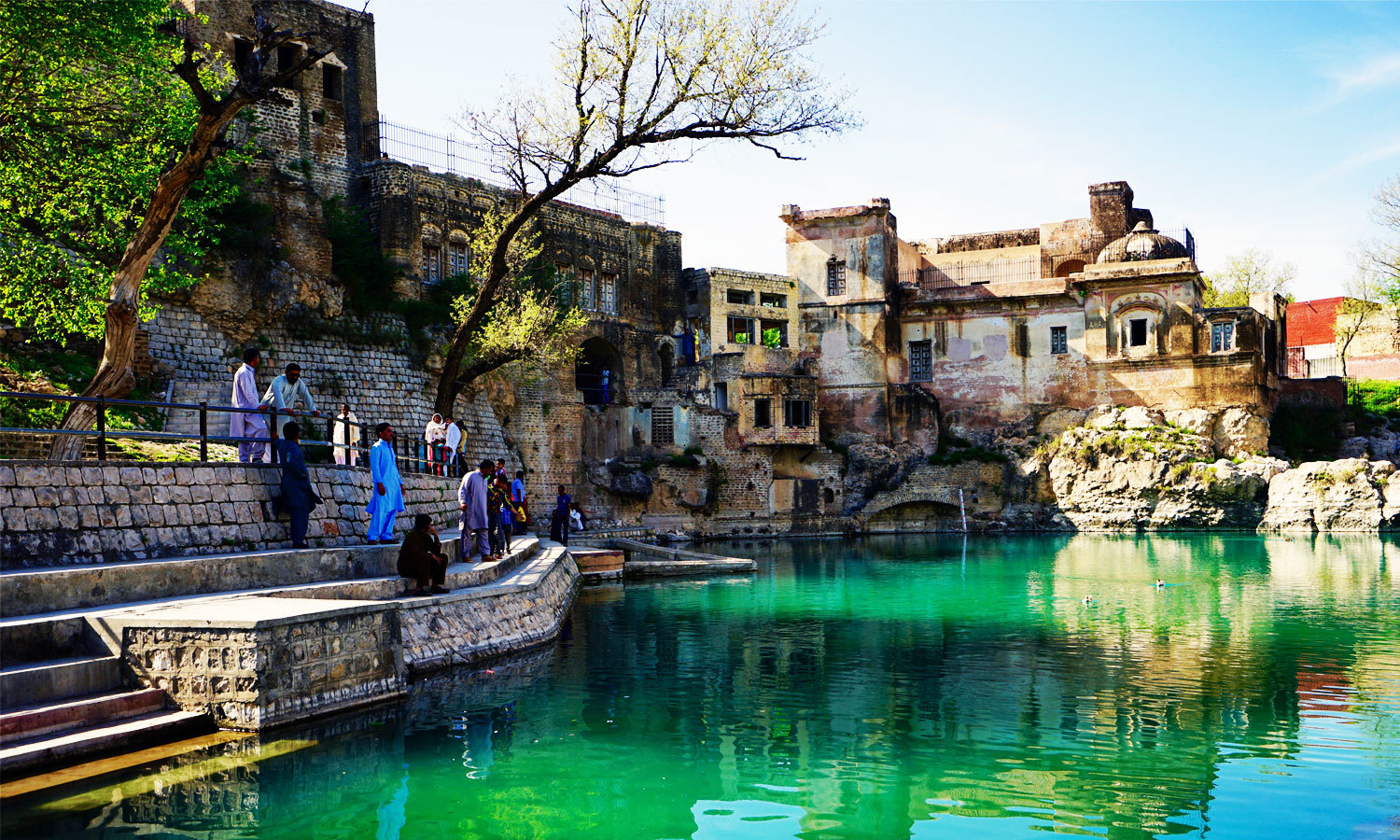
The temples rose like old guardians of time, scattered across the rugged hills. Twenty-six in total, though only a handful remain within the main complex, their stones whispering tales of gods and pilgrims.
At the heart of it all lay the holy pond, shimmering with legends. Hindus believe it was born from the tears of Lord Shiva, shed upon the death of his wife Sati. Even standing there, the story felt alive—the water holding centuries of devotion, grief, and faith.
A guide named Hafizullah walked with me, his words weaving the mythology into the air around us. He pointed to the Shiv Ling stone inside the temple, said to be five thousand years old. Pilgrims once journeyed from far lands to bow before it, their festivals of Shivratri and Nau-Yatra filling these courts with chants.
But today, silence ruled. The temples stood empty, their walls carrying only echoes. I walked through the marquee hall with its twelve doors, where weddings once took place, and climbed the worn steps of the grand Ram Chandra temple with its Mughal-era red stone entrance. From the top, I gazed upon the complex—the pond below, the scattered shrines, the ruins left behind by time.
Some doors were locked, some temples crumbling. Yet there was beauty in their resilience. Even in neglect, the stones refused to forget their stories.
Into the Depths of Khewra
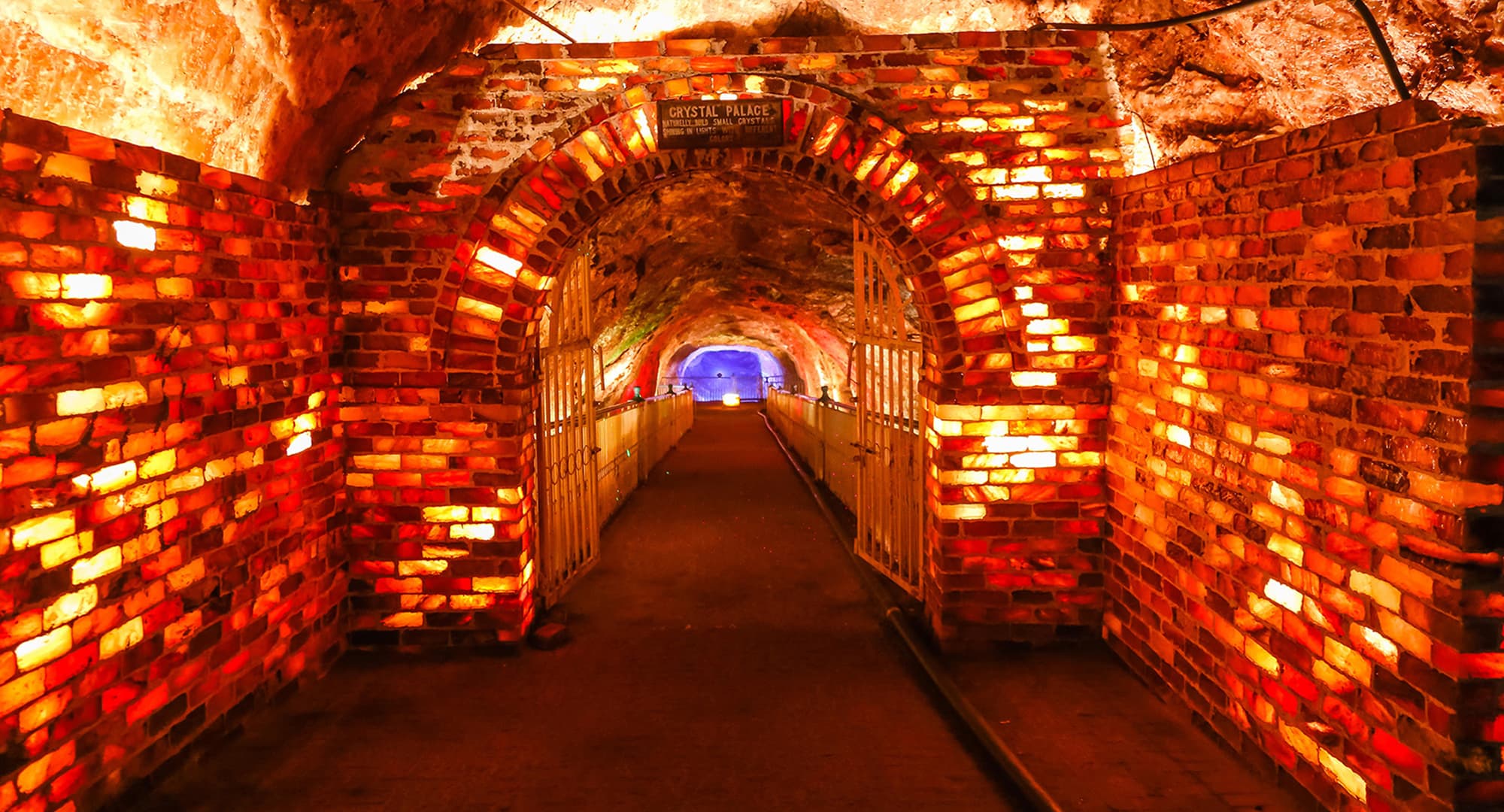
By afternoon, I was back on the road, heading for another wonder: the Khewra Salt Mines, twenty kilometers away. The road twisted through the hills of Choa Saidan Shah, their rocky faces glowing under the sun. At last, the gate of Khewra appeared, welcoming me into the world’s second-largest salt mine.
Salt has been carved from these mountains since the days of Alexander the Great. Legend says it was his horses who first discovered it, licking the rocks after a battle with Raja Porus. Centuries later, the British expanded the mine, digging tunnels that stretch seventeen levels deep.
I entered the darkness on foot, though a small train also ferries visitors. The air inside was cool and sharp, carrying the faint taste of salt. The walls glittered with crystals, carved into mosques, halls, and arches. In one corner stood the famous salt mosque, where miners and tourists alike pause to pray.
A guide explained how only half of the salt is ever extracted; the other half is left behind to support the weight of the mountains, preventing collapse. The sheer scale humbled me—millions of tonnes of salt lying beneath the earth, much of it untouched.
I touched the walls, ran my hand along the cool, damp surface, and thought of the miners who spend their days here, carving the earth for our tables.
The Rough Ride to Jhelum
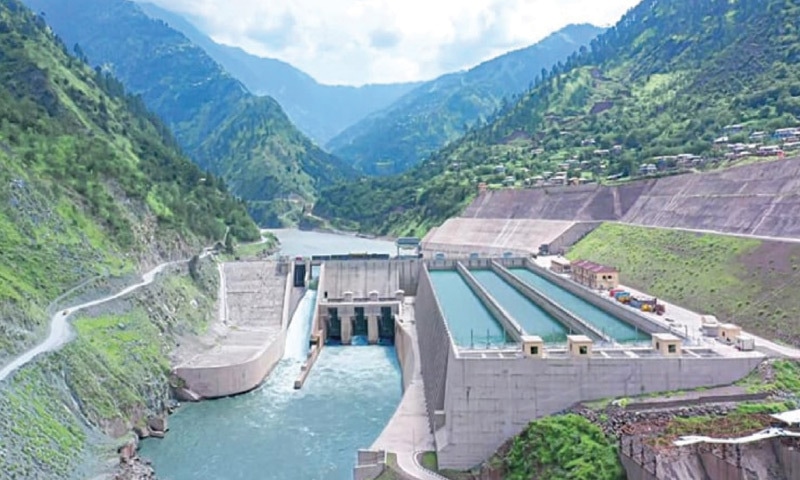
By the time I left Khewra, the sun had begun to sink. My plan was to reach Jhelum for the night, barely ninety kilometers away. But plans are fragile things in Pakistan’s countryside.
The road tested every nerve. Broken patches shook my bones, hidden potholes lurked in the shadows, and more than once I wondered if I should stop and camp instead. Yet I pressed on.
It was past ten at night when I finally rolled into Jhelum, exhausted, my eyes stung by dust and headlights. The town welcomed me with its own chaos, but I was too tired to notice. I found a hotel—Diwan-e-Saeed—and collapsed into its modest comfort.
Dinner was karrahi at a small restaurant called Handi House. Simple, but delicious after a day like this.
As I lay down to rest, my thoughts drifted back to the ancient tears of Shiva and the glittering salt of Alexander’s horses. From mythology to minerals, today had been a journey through time itself.
Tomorrow, though, would be different. Tomorrow I would leave Punjab behind and ride into Kashmir, towards Mirpur, towards a land of valleys, shrines, and forts.
The real adventure was yet to begin.
First Steps into Kashmir – Mirpur, Shrines & Ramkot Fort
Bismillah-ir-Rahman-ir-Raheem.
The morning in Jhelum carried a strange excitement. Punjab had offered its share of history—the whispers of Katas Raj and the depths of Khewra—but now the road turned towards Kashmir. My heart beat faster with every kilometer, for this was not just a destination, it was a dream.
I packed my bags, secured them once more against the motorcycle, and whispered a prayer:
“Ya Allah, keep this day safe, open the roads before me, and let me return with stories worth telling.”
Arrival at Mirpur – A City by the Lake
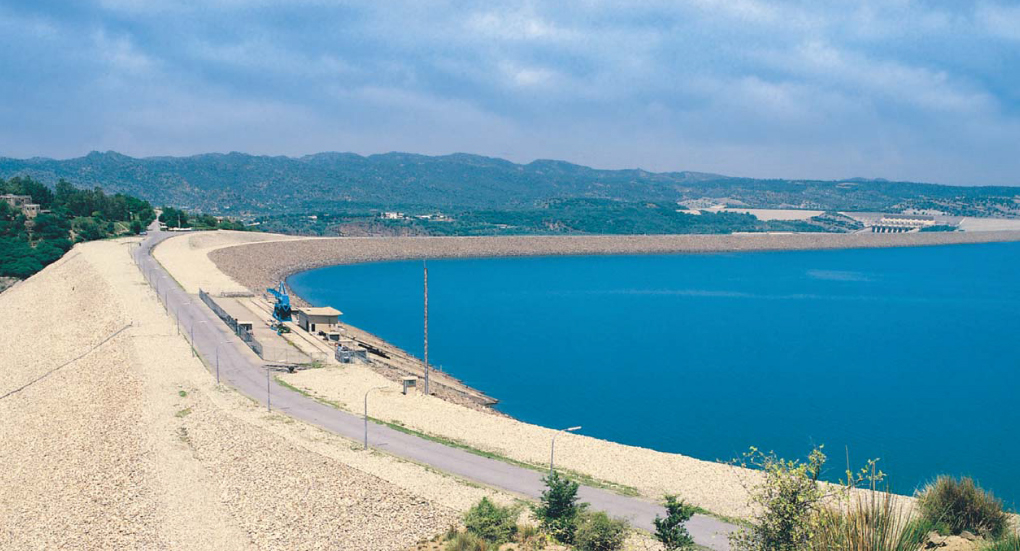
The ride from Jhelum towards Mirpur was smoother than the rough patches of last night. Gradually, the plains gave way to undulating hills, the air freshened, and soon the shimmering waters of Mangla Dam appeared, vast and majestic, like an inland sea.
Mirpur, often called “Little England” because of its diaspora abroad, stood bustling and alive. The streets were lined with shops, and the energy was unmistakable. Here, everyone seemed to have a relative in Birmingham, Manchester, or Luton, and English accents floated in the air like an unexpected soundtrack.
I found a modest guest house to rest my bags, then headed straight towards the shrine of Mian Muhammad Bakhsh, the great Sufi poet whose verses had shaped generations.
Shrine of Mian Muhammad Bakhsh

The shrine lay peacefully near the Jhelum River. Its courtyard was simple yet radiant with devotion. Here rested the man who gifted the world the epic Saif-ul-Malook—a tale of love, struggle, and spiritual awakening.
As I stepped inside, the atmosphere changed. People sat quietly, heads bowed, reciting verses, or whispering their prayers. I placed my hand upon the cool marble, my lips moving softly with dua.
I remembered his words about the fleeting nature of the world, about journeys of the soul far greater than any road I could ride. For a traveler like me, those verses struck deeply. My motorcycle might carry me across mountains and rivers, but true safar was always inward.
The Journey to Ramkot Fort
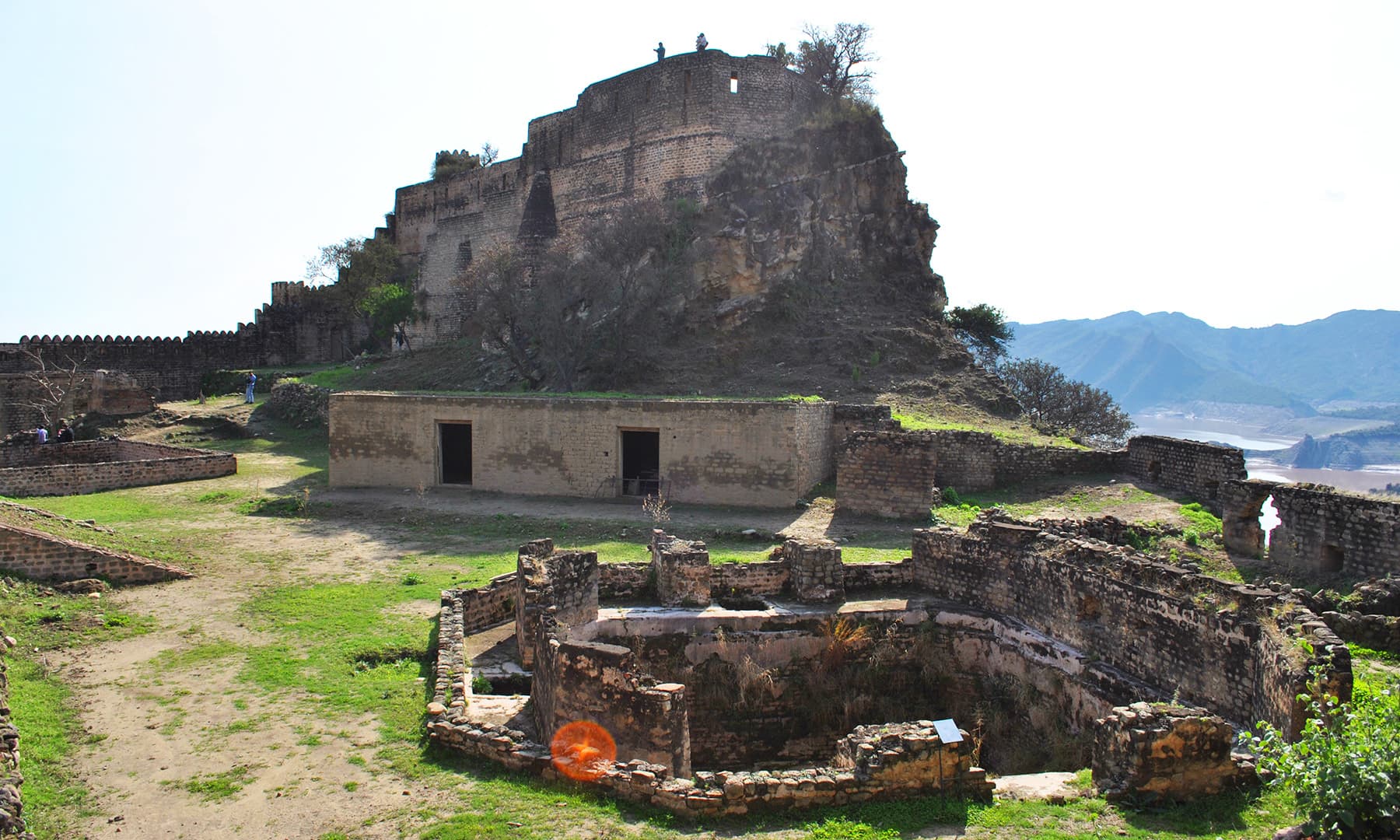
From Mirpur, my compass pointed towards one of Kashmir’s most extraordinary sights: Ramkot Fort. But reaching it was no ordinary ride. First, I had to descend towards the waters of Mangla Dam and find a boat.
The ferry rocked gently as we crossed the blue expanse. My motorcycle stood loaded on the wooden deck, its reflection shimmering in the water. Fishermen sang in the distance, their nets glistening under the sun. For a moment, I felt as though I was riding not through land, but across time itself.
When the boat touched the shore, the fort rose before me, standing proudly atop a green hill.
Ramkot Fort – Guardian of the Waters
Built by the Dogra rulers, and restored during Mughal times, Ramkot Fort is one of those places that humbles a traveler. Its massive stone walls rise dramatically against the lake, its towers watching over the waters like eternal sentinels.
I climbed the steep path to its entrance, the motorcycle left below. The air smelled of grass and stone, the silence broken only by birds. Inside, wide courtyards opened to the sky, arched windows framed the lake like paintings, and crumbling stairways hinted at battles long forgotten.
Standing on its highest wall, the world stretched out before me—blue waters on one side, green valleys on the other. Here, history and nature met, whispering stories of soldiers and sultans, lovers and poets.
Hospitality of Mirpur
Back in the city that evening, I was greeted with the kind of warmth only Kashmiris can offer. A local family invited me for tea. The samovar steamed as cups of pink Kashmiri chai were poured, thick with milk and almonds, alongside fresh bread.
We spoke of travel, of families abroad, of how Mirpur had grown with the money and memories of those who left but never forgot. Their laughter filled the room, and once again I felt the truth: no journey is ever complete without the people you meet along the way.
That night, as I lay in my guest room, the sound of the dam’s waters faint in the distance, I felt the journey truly beginning. Punjab had been the doorway, but now I had stepped into the valleys of Kashmir.
Tomorrow’s road would take me deeper—towards Kotli, waterfalls, tunnels, and stories hidden between mountains.
The safar was unfolding, one turn at a time.
Kotli & Beyond – Waterfalls, Tunnels & Kashmiri Hospitality
The sun rose softly over Mirpur, casting its golden glow across the waters of Mangla Dam. After breakfast and a quick check on Rangeeli, I tightened the straps on my luggage, adjusted my mirrors, and whispered my daily prayer:
“Ya Allah, keep my path safe, and let the road be kind.”
The plan for the day was clear: ride from Mirpur towards Kotli, a city wrapped in mountains, valleys, and rivers. But in Kashmir, no plan ever unfolds without a surprise.
The Ride to Kotli
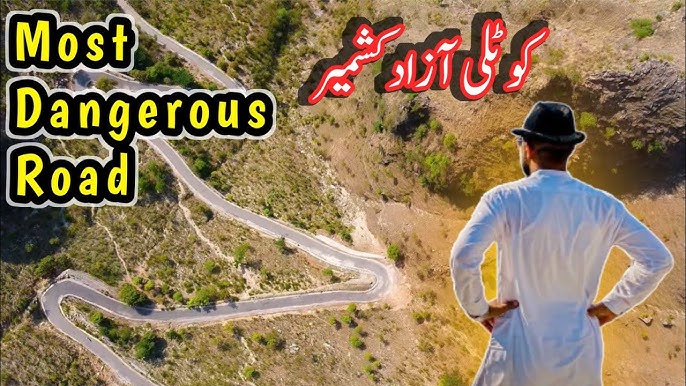
The road began gently, winding through hills scattered with villages. Each turn opened new views—mud houses painted with bright colors, children waving from the roadside, women carrying bundles of wood on their heads, their dupattas fluttering like flags of resilience.
The route through Dadyal was breathtaking. At times, the road clung tightly to the mountain’s edge, and at others, it dove into valleys where rivers flowed like silver threads.
Every few kilometers, waterfalls tumbled down from unseen heights, splashing across the road. Some were small, trickling quietly into mossy rocks. Others roared with power, forcing me to stop and admire their beauty. The spray kissed my face, cooling me against the warmth of the day.
Through the Tunnels
Between Dadyal and Kotli, the journey tested both man and machine. Narrow tunnels carved into the mountains appeared suddenly, their mouths dark and damp. Inside, the sound of Rangeeli’s engine echoed like thunder. The air was heavy, the walls dripping with moisture, and for those few moments, I felt as though I had entered the mountain’s beating heart.
Emerging from the other side, the world always felt brighter, fresher, as if I had been reborn with every passage.
Arrival at Kotli
By afternoon, the city of Kotli welcomed me. Nestled among steep hills, its markets buzzed with life—vendors calling out, smoke rising from kebab stalls, motorbikes weaving through narrow lanes. Unlike Mirpur’s modern diaspora energy, Kotli felt more rustic, closer to its traditions.
I found a small guest house on the edge of town. Simple walls, a charpai in the courtyard, and the kind of quiet that promises good rest.
An Evening with Locals
As the sun dipped behind the hills, I was invited by a local shopkeeper I had met earlier on the road. “Guest is a blessing,” he said, and insisted I join his family for dinner.
Their home was modest but warm. A carpet spread on the floor, cushions arranged around, and the samovar bubbling in the corner. They served me Kashmiri rogan josh, tender lamb in a rich red gravy, with warm naan and bowls of chutney. Later came pink Kashmiri chai, thick with pistachios and almonds, its fragrance lingering long after the cup was empty.
We spoke late into the evening—about my journey, their lives near the border, the hardships of roads closed during shelling, and the beauty that still draws travelers despite it all. Their hospitality humbled me.
When I finally stepped out into the night, the sky above Kotli was alive with stars, brighter than I had seen in weeks. I paused, took a deep breath, and whispered thanks.
That night, lying in the guest house, the roar of waterfalls still echoing in my ears, I thought of how each valley had its own soul. Mirpur had given me history and shrines, Kotli had given me its people. Tomorrow, the road would lead me higher still—towards Rawalakot, Tatta Pani, and the pearl valleys of Poonch.
The safar was only just beginning to reveal its treasures.
Pearl Valley Adventures – Tatta Pani, Banjosa Lake & Toli Peer
Leaving Kotli behind, I rode into a morning filled with promise. The road ahead wound through mountains and valleys, each turn opening into another canvas painted by Allah’s hand. My destination for the day was Rawalakot, famously known as the “Pearl Valley.” But before that, there were stories waiting in the steaming waters of Tatta Pani.
Tatta Pani – The Hot Springs
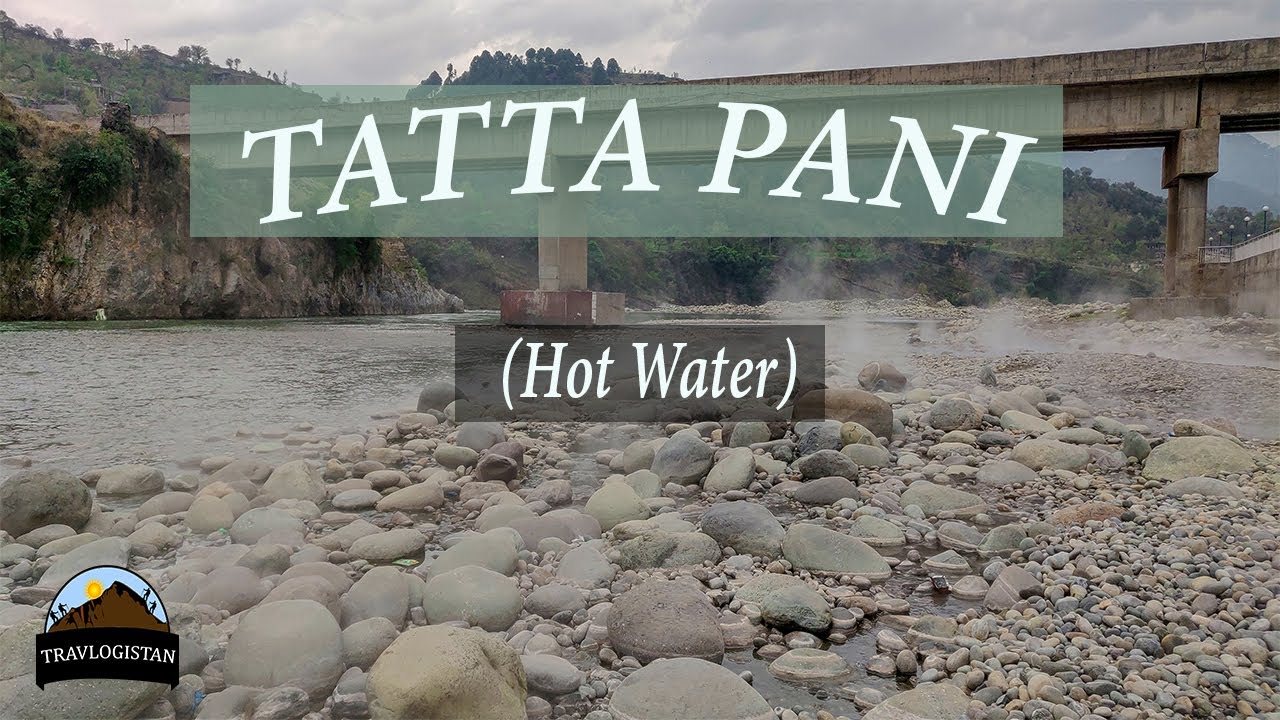
The road dipped and curved until it followed the line of the Poonch River. Soon, the unmistakable sight of steam rising from the riverbank appeared—Tatta Pani, the hot springs known for their healing powers.
I parked Rangeeli near the edge and walked down to the springs. The water bubbled naturally, carrying with it a faint smell of minerals. Locals believe it heals skin diseases and joint pains. I saw travelers from far-off towns dipping their feet, some even immersing themselves fully in the natural pools.
A man with a weathered face told me, “Bhai, yeh paani dawa hai. Jo yahan aata hai, Allah ki rehmat le kar jata hai.”
(Brother, this water is medicine. Whoever comes here leaves with Allah’s blessings.)
I didn’t bathe, but I sat near the steaming flow, feeling its warmth rise into the cool mountain air. For a while, I simply listened—the hiss of water, the murmur of people, the rush of the river beside it. It felt like a pause in the journey, a reminder that even the earth has ways to heal itself and its people.
Arrival at Rawalakot – The Pearl Valley
By afternoon, the road climbed higher, wrapping itself around green ridges. At last, the valley of Rawalakot unfolded before me, a wide bowl of emerald hills and scattered houses. True to its name, it looked like a pearl cradled in the palm of mountains.
The city itself buzzed with life—markets alive with vendors, colorful Kashmiri shawls displayed in stalls, the aroma of kebabs drifting through narrow streets. But it was the surrounding nature that held me spellbound.
Banjosa Lake
Eight kilometers from the city lay Banjosa Lake, and it was there I rode before evening. As I approached, tall pine trees rose like sentinels, their reflection shimmering in the water below. The lake was calm, its surface broken only by the ripples of a rowboat moving lazily.
Families picnicked along the banks, children’s laughter echoing through the trees. I walked along the edge, my boots crunching on the gravel, and breathed in the scent of pine needles. A cool breeze swept across the water, carrying with it the songs of unseen birds.
I sat quietly for a while, watching the sun dip lower, painting the sky in hues of orange and purple. The stillness of the lake seeped into my soul.
Toli Peer – Camping Above the Clouds
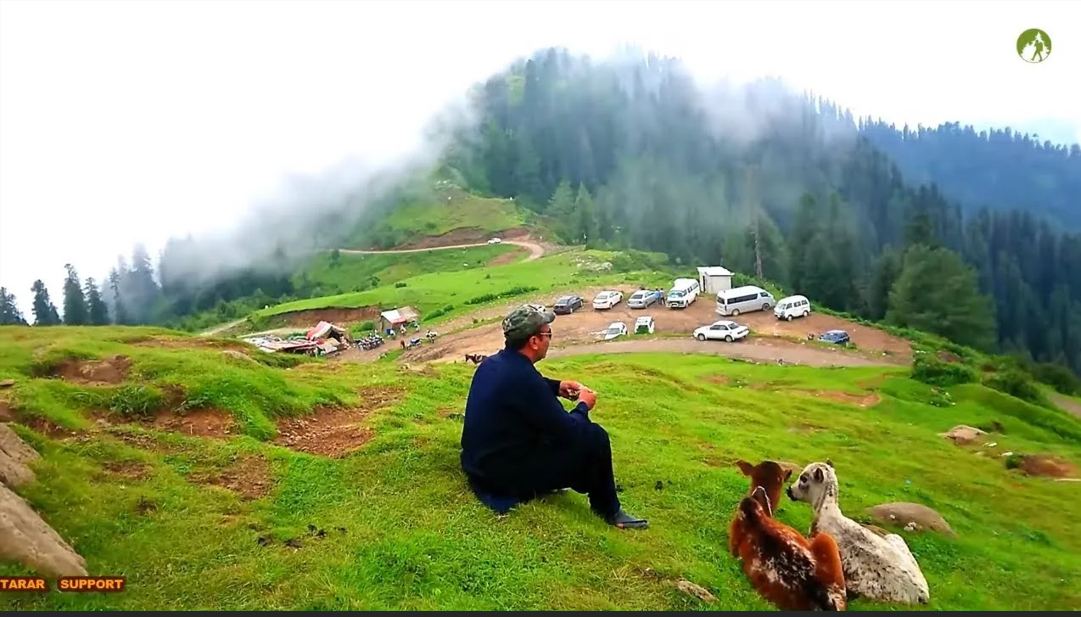
Before the day ended, I pushed further—to Toli Peer, a meadow perched nearly 9,000 feet above sea level. The ride tested every nerve, the narrow road climbing steeply, bends sharp enough to challenge even the strongest rider. But when I finally reached the top, every hardship was forgotten.
The world stretched endlessly in every direction. Rolling green meadows spread like carpets, dotted with wildflowers swaying gently in the evening breeze. Clouds drifted so close that it felt as if I could reach out and touch them.
I set up my small camp there, the tent pitched on soft grass. As night fell, the temperature dropped sharply, and I wrapped myself in layers, sipping warm tea made on my portable stove. The silence was immense, broken only by the rustling of wind across the meadow.
Above, the sky was ablaze with stars. Countless, endless, shining with a brilliance I had never seen from any city. It felt as though the heavens had opened their treasure chest, scattering diamonds across the night just for me.
Sitting there, alone yet not lonely, I realized this was why I traveled—not just for roads and destinations, but for moments where the soul feels both small and infinite at the same time.
That night, under the star-filled sky of Toli Peer, I slept with gratitude in my heart. Tomorrow would bring the high peaks of Ganga Choti and the hidden valleys of Leepa.
The safar was climbing higher, towards the roof of Kashmir
High Peaks & Hidden Valleys – Ganga Peak & Leepa Valley
The cold morning air at Toli Peer woke me before sunrise. My tent was heavy with dew, the meadow silent except for the faint whistle of wind brushing across the grass. I stepped outside, my breath fogging instantly, and watched as the first light spilled over the horizon. It was time to chase the heights.
My plan for the day was ambitious—first climb Ganga Choti (Ganga Peak), and then descend into the fabled Leepa Valley, one of Kashmir’s most secluded gems.
The Ride to Ganga Choti
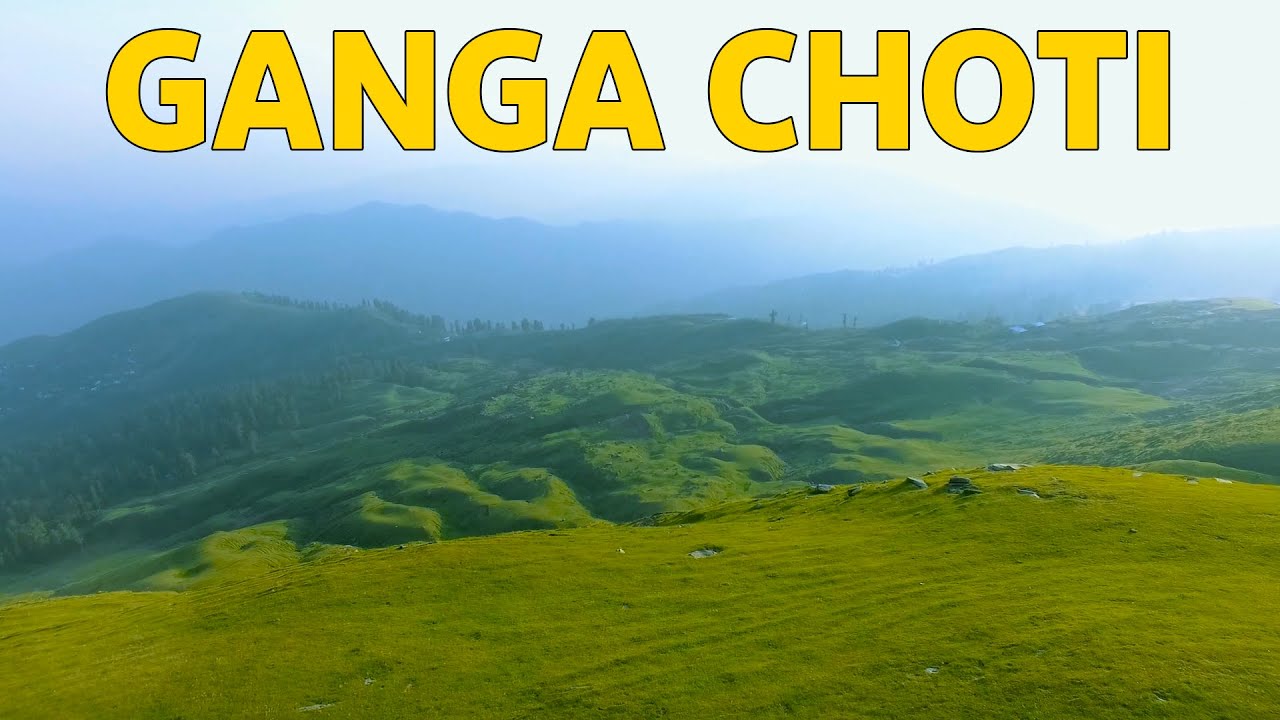
From Rawalakot, the road twisted sharply upwards, a narrow ribbon carved into the mountain’s edge. Pines lined the path, their tall shadows stretching across the road. As I climbed higher, the settlements grew fewer until only scattered huts remained, their smoke rising like lonely prayers into the sky.
The track turned rough near the top—broken stones, mud patches, and sharp bends that forced me to slow to a crawl. Rangeeli grumbled beneath me, her tires clawing for grip, but she carried me steadily, faithfully.
At last, I reached the trailhead. The motorcycle could go no further. The rest had to be on foot.
The climb was steep, my boots sinking into soft earth, heart pounding with each step. But then, as I crested the ridge, the world opened before me.
Ganga Choti stood like a throne above the clouds. To the east, snowcapped ranges gleamed under the sun. To the west, rolling green valleys tumbled endlessly. Below, white clouds floated like seas of cotton, and I felt as though I had stepped into another world—neither earth nor sky, but somewhere in between.
I sat quietly on a rock, the wind rushing past, and whispered a prayer of gratitude. These were the places where one feels truly small yet deeply connected, where the soul finds both humility and strength.
Descent into Leepa Valley
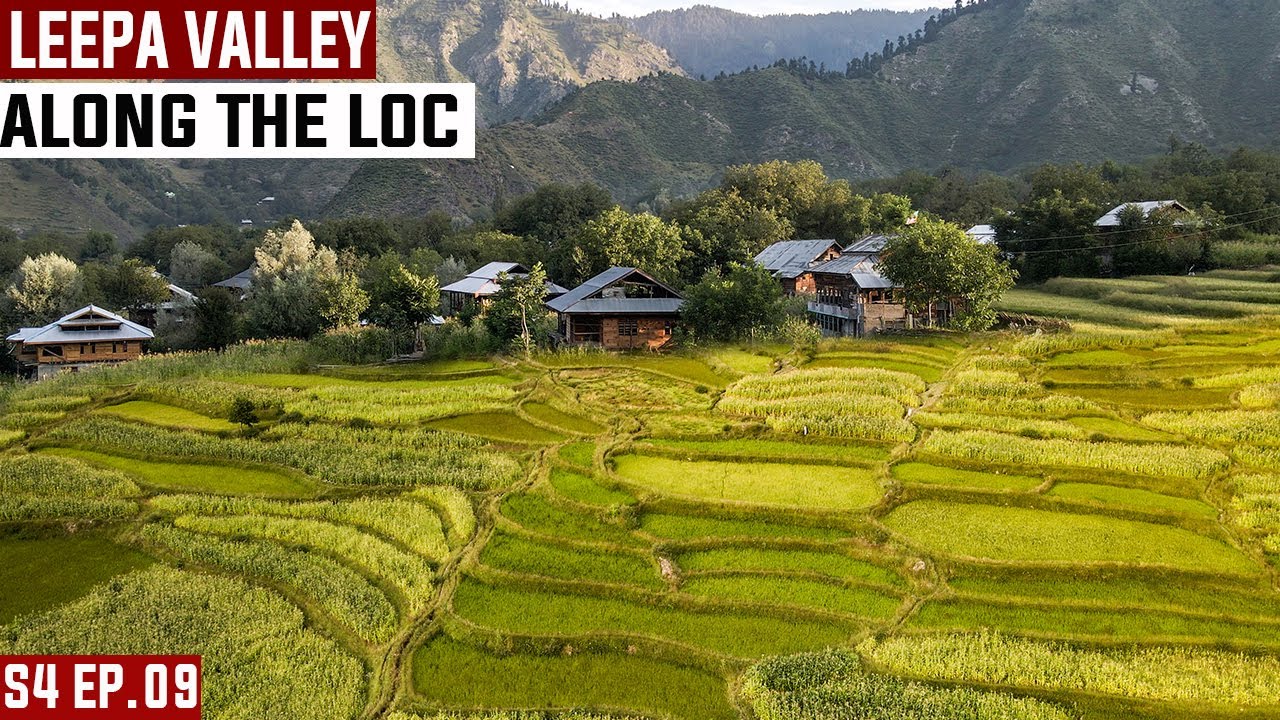
By afternoon, I turned my motorcycle towards Leepa Valley, known as the “heaven within heaven.” The descent was treacherous—narrow mud roads clinging to cliffs, sharp turns that revealed dizzying drops into the valley below. More than once, I had to stop, breathe, and gather courage before proceeding.
But as the road finally widened and the valley revealed itself, I understood why every hardship was worth it.
Leepa stretched out like a painting—lush fields bordered by walnut and apple trees, wooden houses with slanted roofs designed for heavy snow, streams rushing with crystal water. The people here lived close to the border, their lives marked by simplicity and resilience.
In a small village near Naukot, I stopped for tea at a wooden house. The host, a kind man with weather-beaten features, welcomed me warmly. His family brought out fresh bread, honey, and steaming cups of Kashmiri chai.
As we sat on the veranda, he pointed towards the distant ridges.
“Bas us paar hai line of control,” he said softly.
(Just beyond those ridges is the Line of Control.)
The thought sent a chill through me. To live here was to live with beauty and danger side by side. They spoke of times when shells had fallen in their fields, of nights spent in fear, yet their faces carried no bitterness. Instead, there was pride, strength, and hospitality that humbled me deeply.
Evening in Naukot
I was offered a place to stay, and I accepted with gratitude. That night, the valley lay cloaked in silence, broken only by the sound of the river. The wooden house creaked softly with the wind, and I lay on a charpai under thick blankets, staring through the window at stars glimmering above the black ridges.
The safar had brought me to one of the most beautiful yet fragile places on earth—a valley cradled in paradise, yet shadowed by conflict.
As I closed my eyes, I promised myself to carry its stories, its voices, and its resilience with me..
Return & Reflections – Muzaffarabad, Baboon Valley & Galiyat
The morning in Leepa Valley was crisp, the fields silvered with dew, the mountains glowing softly in the dawn. I packed my bags slowly, reluctant to leave. The wooden house where I had stayed was still asleep, except for my host, who handed me a cup of steaming chai before I set off. His words were simple:
“Safar hamesha Allah ke naam se shuru karna.”
(Always begin a journey in Allah’s name.)
And so I did.
Muzaffarabad – The City of Rivers
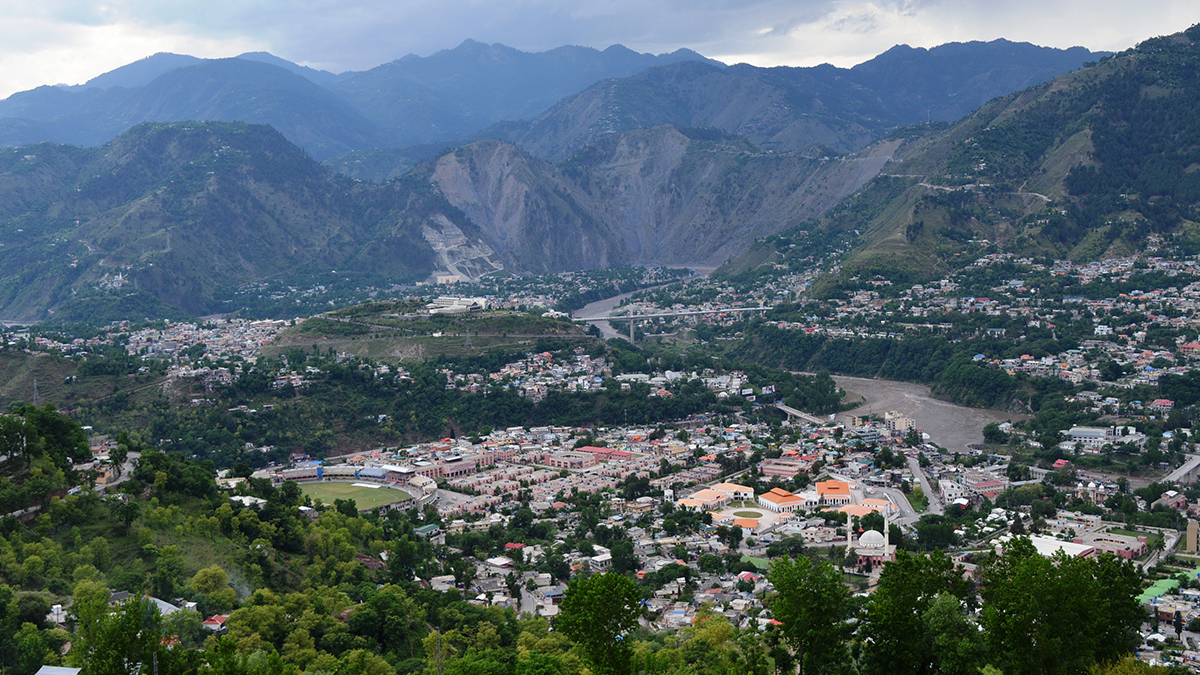
The road out of Leepa was rough, but by midday I reached Muzaffarabad, the capital of Azad Kashmir. Nestled between the Neelum and Jhelum rivers, the city pulsed with life. Bridges arched across turquoise waters, markets overflowed with spices, shawls, and fruits, and the hills wrapped the city in a green embrace.
I was welcomed by the local Jeep Club, who had heard of my journey. Their hospitality was boundless—they treated me as a brother, offering food, guidance, and a place to rest. We spoke of off-road tracks, of the thrill of adventure, and of the countless stories the mountains held.
Muzaffarabad was a city of contrasts—modern roads cutting through centuries-old bazaars, military convoys passing by shrines, laughter of children mixing with the roar of rivers.
Baboon Valley – The Rough Ride
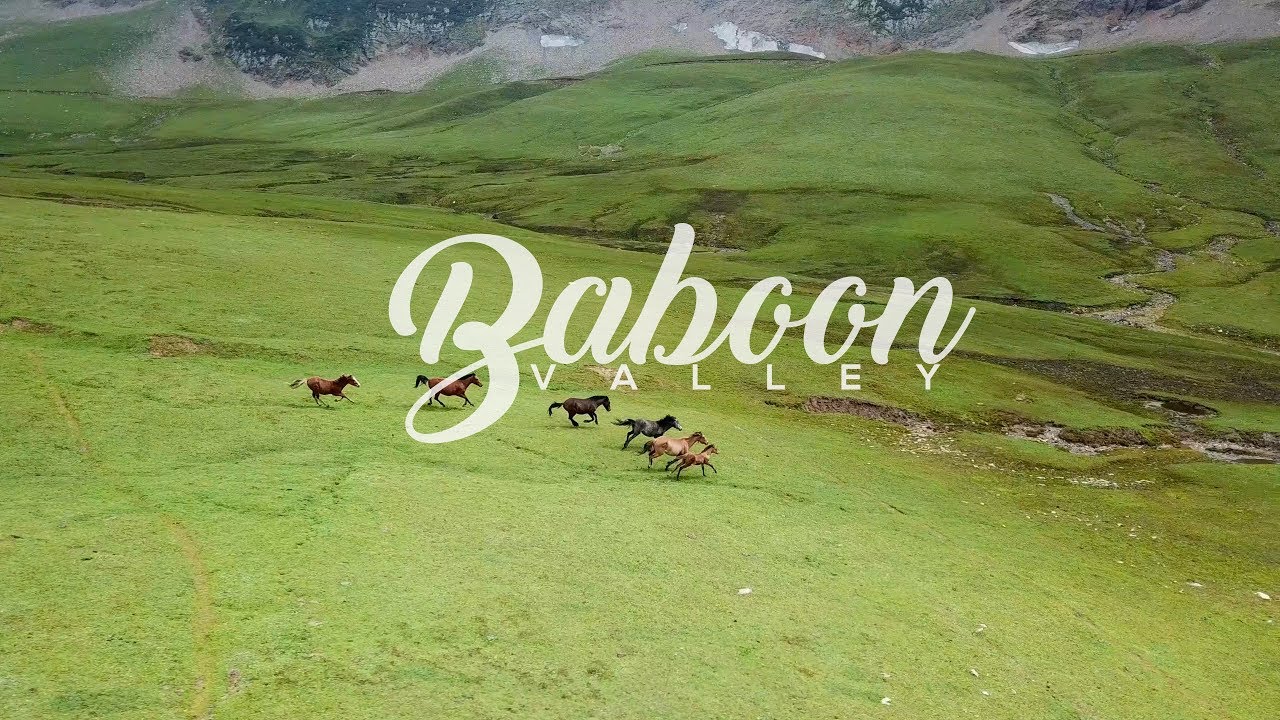
From Muzaffarabad, I turned my motorcycle towards Baboon Valley, a place whispered about by travelers for its raw beauty and equally raw difficulty.
The road quickly vanished into a trail of mud and rocks. Rangeeli struggled, slipping on wet stones, tires sinking into slush. More than once I had to get off and push, my boots covered in mud, my body aching with the effort.
But when I finally broke through the last ridge, the valley opened before me in a spectacle of wild grace—vast meadows carpeted in wildflowers, streams dancing across the land, and peaks that touched the very sky.
Here, time seemed forgotten. Shepherds led their flocks across the grass, their voices echoing against the cliffs. Children ran barefoot, laughing, their innocence a reminder of life’s simplest joys.
I camped there for a few hours, letting the silence sink in. The hardship of the road was nothing compared to the reward of such beauty.
Through the Galiyat
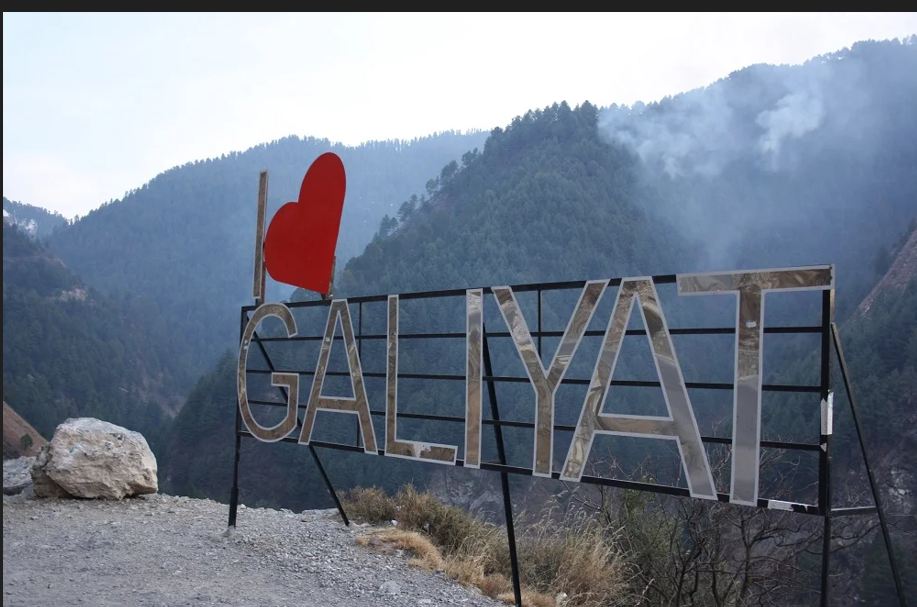
The safar’s final arc carried me back towards Galiyat—through Khanaspur, Nathia Gali, and finally to the serene heights of Mushkpuri Top.
The air grew cooler, fresher, as I climbed. Pine forests lined the roads, their needles carpeting the ground. Monkeys leapt from branch to branch, keeping pace with me as if escorting me through their kingdom.
At Mushkpuri, I left Rangeeli parked and hiked to the top. The trail wound through dense forest, sunlight dripping through the leaves. At the summit, the world spread endlessly—Abbottabad to one side, Kashmir to the other, clouds drifting lazily below.
It was the perfect place for reflection.
Reflections on the Road
As I sat on the peak, the entire safar replayed in my mind—the temples of Katas Raj, the salt of Khewra, the shrine of Mian Muhammad Bakhsh, the fort at Ramkot, the waterfalls of Kotli, the hot springs of Tatta Pani, the meadows of Toli Peer, the heights of Ganga Choti, the valleys of Leepa, and the untamed trails of Baboon.
Each stop had been more than a destination. It was a story, a prayer, a lesson.
Travel teaches patience when the road breaks, courage when cliffs test your balance, humility when mountains dwarf your pride, and gratitude when strangers open their homes to you.
Rangeeli had carried me faithfully, despite mud, rain, and broken roads. And Allah had carried me too, through every danger, every moment of doubt, every turn of the wheel.
That night, as I descended from Mushkpuri and returned towards the plains, my safar in Kashmir drew to a close. But in truth, no journey ever really ends. The road leaves its marks on you—dust on your clothes, scratches on your motorcycle, and stories etched forever into your heart.
I whispered softly as I rode back:
“Alhamdulillah. The safar was beautiful. May Allah grant me many more.”
And with that prayer, my Kashmir journey came to rest—until the next adventure calls.








